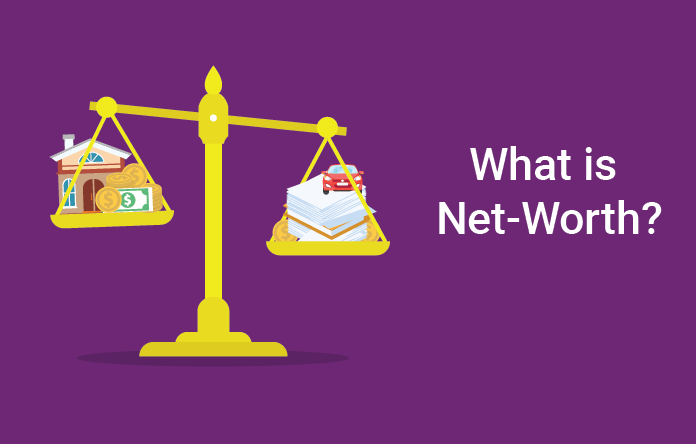Know Where You Stand, So You Know Where to Go
💭 What if I asked:
“How rich are you?”
Would you answer with:
- Your salary?
- Your savings?
- Your car or phone model?
Wrong approach.
The true answer lies in a single number:
Your Net Worth.
🧠 What is Net Worth?
Your Net Worth is the total value of what you own (assets) minus what you owe (liabilities).
🧮 The Simple Formula:
Net Worth = Total Assets – Total Liabilities
It’s the most accurate snapshot of your financial health at any point in time.

🏠 Assets vs. Liabilities – What Counts?
✅ Assets (What You OWN):
These are things that add value to your life or can be converted to cash.
- 💰 Cash in hand or bank accounts
- 🏦 Fixed deposits or recurring deposits
- 📈 Stocks, mutual funds, index funds
- 🪙 Gold or silver
- 🏠 Real estate or property
- 🚗 Vehicles (if owned outright)
- 🧾 PPF, EPF, NPS accounts
- 📦 Business investments
- 👨🎓 Education fund or retirement fund
❌ Liabilities (What You OWE):
These are things that take money away—debts, dues, and obligations.
- 💳 Credit card balances
- 🏠 Home loan
- 🚗 Car loan
- 👨🎓 Education loan
- 👨👩👧👦 Personal loans from family/friends
- 📱 EMIs on electronics or gadgets
- 🧾 Outstanding bills or taxes
📝 Step-by-Step: How to Calculate Your Net Worth
Step 1: List All Your Assets
Make a list and total the current market value of all your assets.
| Asset Type | Example | Value |
|---|---|---|
| Savings A/C | ₹30,000 | ₹30,000 |
| Fixed Deposit | ₹1,00,000 | ₹1,00,000 |
| Mutual Funds | ₹1,50,000 | ₹1,50,000 |
| Gold (10gms) | ₹65,000 | ₹65,000 |
| Car | ₹3,00,000 | ₹3,00,000 |
| Total Assets | ₹6,45,000 |
Step 2: List All Your Liabilities
Now list all the outstanding balances of your debts or dues.
| Liability Type | Example | Outstanding |
|---|---|---|
| Home Loan | ₹20,00,000 | ₹12,00,000 |
| Credit Card | ₹50,000 | ₹50,000 |
| Personal Loan | ₹1,50,000 | ₹1,50,000 |
| Total Liabilities | ₹13,00,000 |
Step 3: Subtract to Find Net Worth
Net Worth = ₹6,45,000 (Assets) – ₹13,00,000 (Liabilities)
= – ₹6,55,000
Yes—it can be negative too. And that’s okay. It’s a starting point.
🎯 What’s a “Good” Net Worth?
There’s no one-size-fits-all, but here are rough benchmarks (for India):
| Age | Target Net Worth |
|---|---|
| 20s | 0 to ₹5 Lakhs (start small, build base) |
| 30s | ₹10–30 Lakhs (start investing aggressively) |
| 40s | ₹40–75 Lakhs (build security + retirement) |
| 50s+ | ₹1 Crore+ (focus on wealth protection & legacy) |
Your number may differ—and that’s fine. What matters is knowing it, and improving it.
📉 Why Most People Never Track Their Net Worth
- They confuse salary with wealth
- They fear facing their debt
- They don’t know where to begin
- No one taught them this in school
But you’re not most people.
You’re here—learning to take control.
📈 Why Tracking Net Worth is a Game-Changer
1. Awareness Creates Growth
What you track, improves.
2. You See Real Progress
Salaries may stay stagnant. Net worth can grow from wise investments.
3. You Make Smarter Choices
Every spend and borrow becomes a net-worth decision.
4. It Motivates Long-Term Thinking
You focus less on monthly income, more on total financial health.
🔄 How Often Should You Track It?
- ✅ Monthly – If you’re aggressively improving your finances
- ✅ Quarterly – If you’re stable and just monitoring growth
- ✅ Annually – Minimum check-in (end of financial year)
Use a spreadsheet, app, or even a notebook—but be consistent.
🛠️ Tools to Calculate Net Worth
- Manual Google Sheet/Excel (Customizable)
- Apps: INDmoney, ET Money, Walnut, Goodbudget
- Financial Advisors: They can provide deeper net-worth statements
Want a FREE Net Worth Calculator?
Reply with “NET WORTH TOOL” and I’ll send you a ready-to-use sheet.
💬 Final Thoughts: Know the Score Before Playing the Game
Net worth is not just a number—it’s your financial report card.
It shows where you are, so you can plan where to go.
Don’t obsess, but don’t ignore it.
✅ TL;DR – Quick Recap
- Net Worth = Assets – Liabilities
- Track cash, gold, real estate, stocks, and debts
- A positive net worth means you’re building wealth
- A negative net worth is a wake-up call—not a life sentence
- Review monthly or quarterly to stay in control








